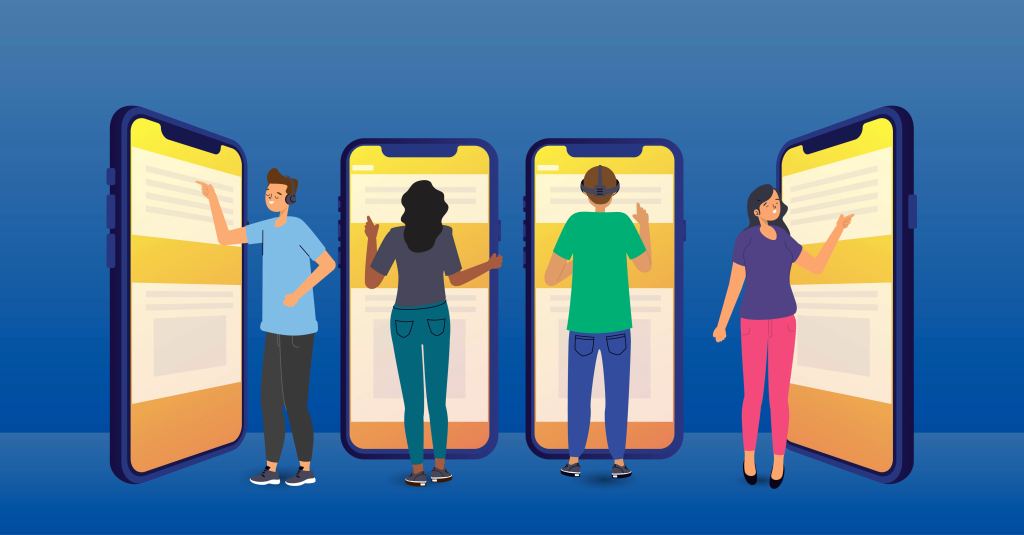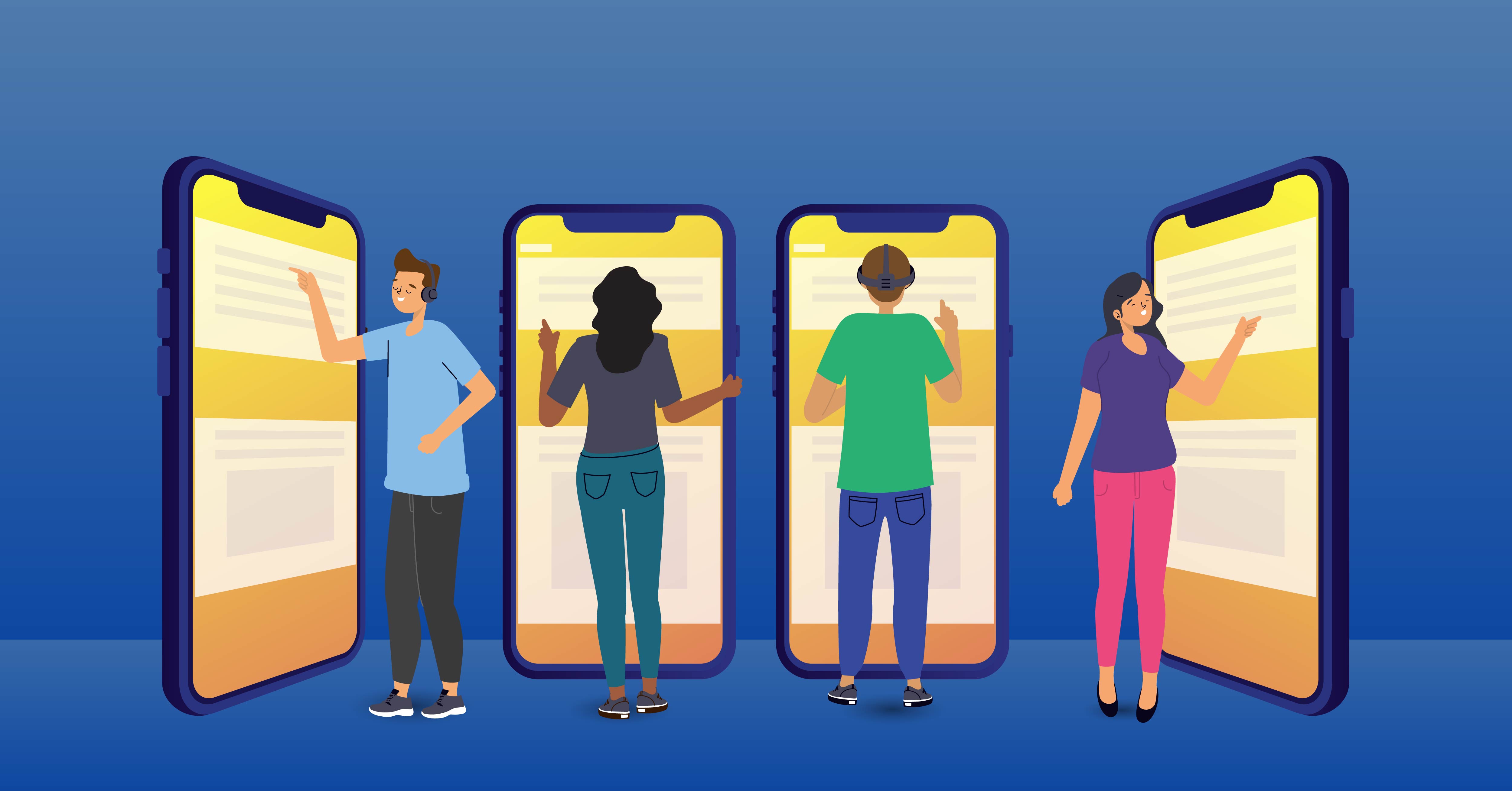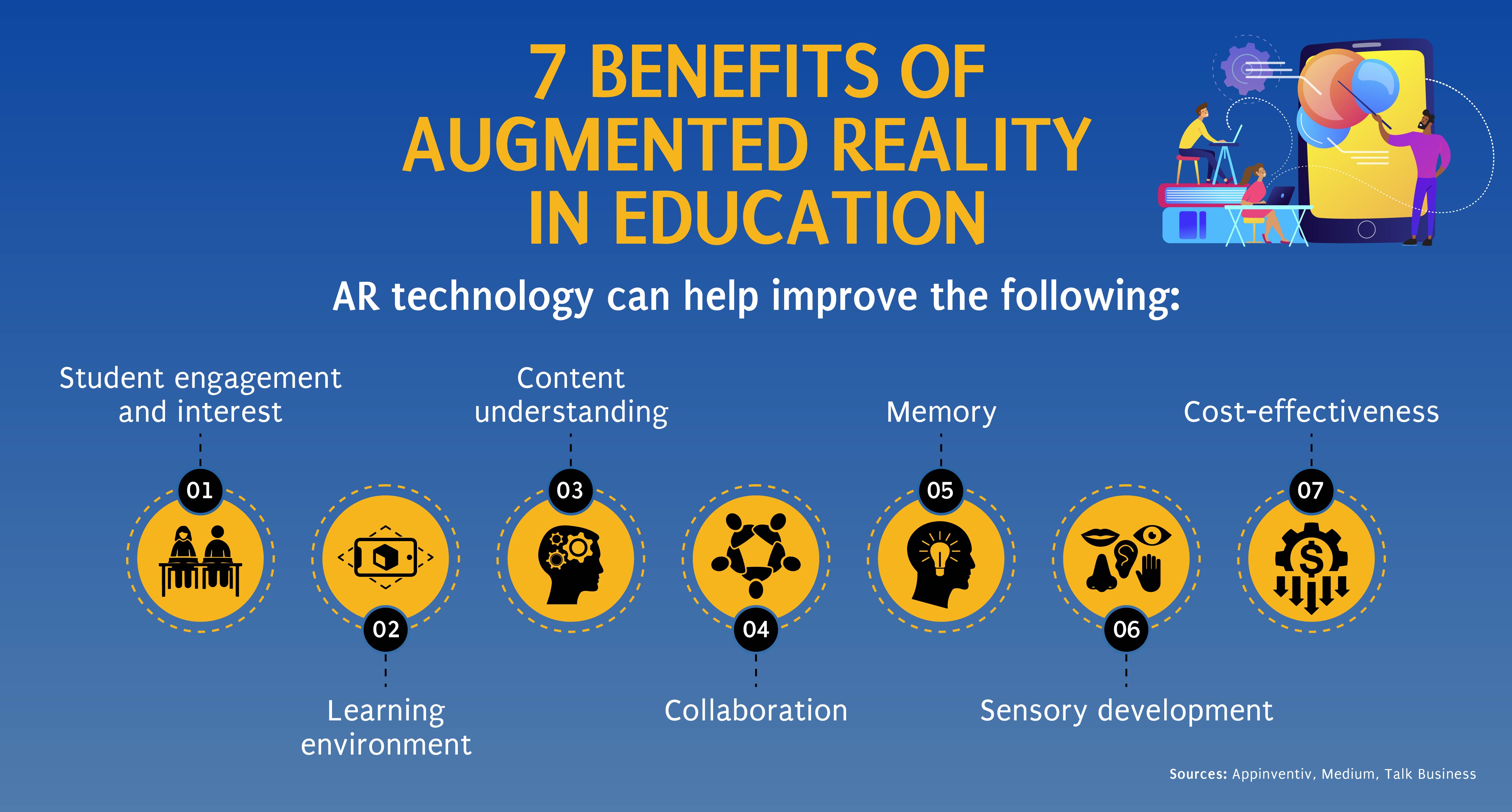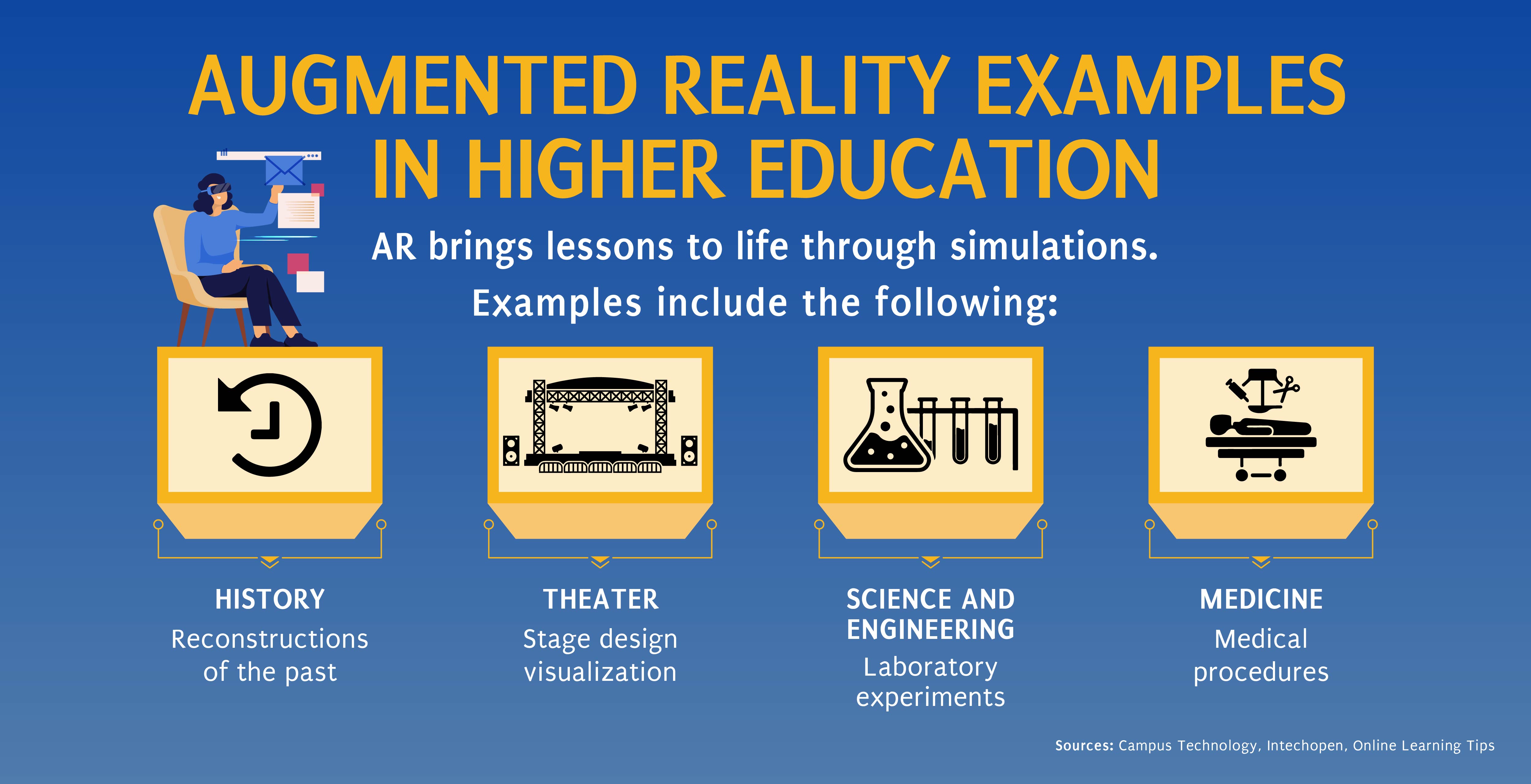Augmented Reality in Education: Interactive Classrooms

Tables of Contents

The Pew Research Center reports that mobile technology use has more than doubled in the past decade from 35% in 2011 to 81% in 2019, with smartphone use especially prevalent among young Americans — about 96% of people ages 18 to 29 own a smartphone. These trends are creating opportunities for using augmented reality in education.
Augmented reality (AR) is a technology that overlays digital information such as sounds, videos, and graphics on top of the real-world environment. AR is often confused with virtual reality (VR), a technology that creates entirely artificial environments. Together, these technologies are collectively known as extended reality (XR), and they are driving change across industries: IDC reports that the AR/VR market is expected to grow from $16.8 billion in 2019 to $160 billion by 2023.
Industries such as engineering, manufacturing, and space exploration commonly use AR in business applications such as research and development. With the emergence of new technologies and widespread adoption of smartphones, educators are increasingly expected to use AR in the classroom.
What is augmented reality?
Augmented reality superimposes sounds, videos, and graphics onto an existing environment. It uses four main components to superimpose images on current environments: cameras and sensors, processing, projection, and reflection.
Each of these components provides an individual function. For example, cameras and sensors can detect an image’s depth or calculate the distance between two objects before superimposing digital content atop the user’s view. Projection and reflection add virtual information over what a user sees; for example, a method known as projection mapping enables AR apps to digitally overlay video onto any physical surface.
As for processing and transmitting data, limited bandwidth and latency of wireless networks have typically posed challenges to wide-ranging adoption of AR. But thanks to faster wireless connectivity through 5G cellular networks and next generation devices’ improved processing power, opportunities to explore AR’s full potential are expanding.
With these core AR components, educational institutions can incorporate interactive classrooms into their curricula. Why use augmented reality in education? Using AR in the classroom can improve learning by helping educators create interactive classrooms that increase student engagement.
Incorporating AR components into daily work practices can also help businesses solve problems and improve inefficiencies.
Examples of AR use in business
AR has many uses across business functions.
- Business presentations: Presenters can face challenges connecting with audiences and delivering messages. Augmented reality engages audiences by making them part of the presentation. For example, instead of asking customers to visualize a light fixture in a certain location, they can use AR to show how it would “really” look.
- Prototyping: During the product development stage, designers typically sketch prototypes digitally or on paper and use CAD modeling to produce a facsimile of the end product. Printing 3D prototypes can be expensive, making alterations costly. AR overlays virtual objects onto existing objects, allowing designers to change prototypes without printing a new one with every change.
- Research and development (R&D): Companies across industries known for their innovation spend billions of dollars each year on R&D. AR technology means faster and better visualization, improved collaboration, and accelerated time to market, reducing costs.
- Training and learning: Presentation is vital to sharing knowledge, and AR can be a handy tool for immersing audiences in their learning. AR applications can have learners move around a room to interact with the content, creating more active educational experiences. This can help them retain knowledge and grasp difficult concepts.
Examples of AR use across industries
AR has many uses across many industries. Here are a few examples:
- Engineering: Common applications for AR in engineering include production, training, and support. In the pump industry, AR helps technicians simulate complicated pump installations in water and wastewater operations rather than relying on a repair manual.
- Medicine and healthcare: From patient education and physician training to surgical visualization and disease prevention simulations, AR’s benefits for healthcare are clear. For example, one healthcare AR application maps a patient’s body, including the precise locations of veins, enabling healthcare professionals to more accurately draw blood or start an IV ahead of a surgical procedure or during a medical exam.
- Retail: AR can enhance interactions between customers and products. A customer browsing through the aisles of a store can point their smartphone toward a product to prompt an AR app to provide relevant information. Retailers like Ikea offer AR-powered apps that enable customers to visualize furniture in their own homes before buying.
- Manufacturing: About 2.4 million positions may be unfilled between 2018 and 2028 due to a growing manufacturing skills gap, according to Deloitte. AR can play a pivotal role in closing that gap and addressing complex processes in manufacturing. For example, manufacturing equipment, which often involves dozens of processes for hundreds of individual components, requires regular maintenance. AR can train a workforce to maintain equipment and perform remote equipment diagnostics, increasing manufacturing workforce productivity.
- Entertainment: While Pokemon Go was not the first AR video game, it has been one of the most popular since its 2016 launch, with more than 1 billion downloads as of February 2019. As 5G technology use increases, AR advances will continue to change how people entertain themselves. According to a Deloitte study, millennials and Generation Zers (those around 14 to 36 years old) plan to use 5G to stream more video, play more online games with social features, and immerse themselves in more AR digital worlds.
- Space exploration: A Lockheed Martin platform that combines machine learning and augmented reality may soon help humans reach Mars. If a mechanical problem arises on Mars, on-site astronauts might not receive repair instructions from Mission Control on Earth for over 40 minutes. This platform includes an AR visor that displays an overlay of data, such as thermal, gas mixtures, and other vital information, atop a physical space, which can help astronauts find their own timely fixes.
- Military and defense: Nothing can replace the intense and grueling physical aspects of training soldiers for combat. But augmented reality is enabling the military to add a layer of training that can help produce better soldiers. These apps improve situational awareness and train users to process information quickly and safely. For example, tactical augmented reality (TAR) provides tactical mapping during a military operation to help soldiers find friends and identify foes.
Resources
The following resources provide data and other information about what augmented reality is and how it’s used across industries.
- Appinventiv, “AR/VR Trends and Predictions for 2020 & Beyond” — A look at trends and predictions for the future of the AR/VR market with various industry examples
- Light Guide Systems, “8 Industries Benefiting from Augmented Reality” — An overview of industries actively using AR technology in business and operational processes
- Live Science, “What Is Augmented Reality?” — A history of augmented reality and a glimpse of its future
- VXchnge, “Top 7 Augmented Reality Statistics for 2020 [+ Use Cases]” — Statistics and data that provide insights as to where the AR market is headed
Benefits of augmented reality in education
AR is increasingly being adopted in educational settings, often to help students with complicated subjects. For example, students struggling with geometry can use AR to see and manipulate 3D geometric forms. Another application of augmented reality in education includes teaching global perspectives through virtual field trips, enabling students to interactively engage with other cultures.
While AR and similar technologies such as VR are becoming more popular in education, less than 10% of schools currently use augmented reality in the classroom, according to Project Tomorrow. Some reasons cited for the slow adoption of AR in education include:
- Bulkiness of AR equipment
- Quality of AR educational content
- Concerns over its academic value
- Lack of proper funding
AR creates opportunities for teachers to help students grasp abstract concepts. By using the interaction and experimentation that AR technologies offer, teachers can enhance classroom experiences, teach new skills, inspire student minds, and get students excited about exploring new academic interests.

AR technology can help improve the following: student engagement and interest, learning environment, content understanding, collaboration, memory, sensory development, and cost-effectiveness.
Benefits of AR
AR can have a significant impact on learning environments:
- Student engagement and interest: Student interest skyrockets with the opportunity to engage in creating educational content. AR technologies can allow them to add to curriculum content, create virtual worlds, and explore new interests.
- Learning environment: Classes that incorporate AR can help students become more involved. An interactive learning environment provides opportunities to implement hands-on learning approaches that can increase engagement, enhance the learning experience, and get students to learn and practice new skills.
- Content understanding: Lack of quality content focused on education, rather than entertainment, is a noted concern among teachers hesitant to use augmented reality in education. However, existing AR technology enables teachers to create immersive educational experiences on their own to help ensure their students understand curriculum content.
- Collaboration: As AR content is digital, it is easily shared. For example, a group of teachers can work with their students to continually refine the content. A collaborative learning environment provides students with increased motivation to learn because they are actively engaged in the educational content creation process.
- Memory: AR is an excellent tool for bringing lessons to life and helping students remember essential details. For example, instead of just presenting photographs on a projector showcasing life in Colonial America, a teacher can use AR technology to create memorable interactive stories.
- Sensory development: AR technology can help teachers create lesson plans with multisensory experiences. Students benefit from immersive virtual content that incorporates an experiential learning style in which students carry out physical activities instead of watching a demonstration. This approach can help with sensory development.
- Cost-effectiveness: The cost of AR equipment is often cited as a barrier to adoption. However, as smartphone use continues to rise among young Americans, and since smartphones are already equipped with the hardware needed to run AR apps, augmented reality in education is increasingly more cost-effective to implement. Additionally, AR can lower educational costs by replacing expensive textbooks.
Resources
Learn more about the benefits of augmented reality in education:
- EdSurge, “Five Ways Teachers Can Use — and Create — Augmented Reality Experiences” — Innovative ways teachers are using AR in the classroom
- EdTech, “Here Is What the Right Tools for Mixed Reality in the Classroom Look Like” — Insights on maximizing augmented reality in education investments
- Interesting Engineering, “Augmented Reality: The Future of Education” — AR strategies, tools, and platforms that can help accelerate STEM and coding learning
- The Tech Edvocate, “4 Benefits of Using Augmented Reality in the Classroom” — Key benefits of AR in teaching
- ViewSonic, “6 Benefits and 5 Examples of Augmented Reality in Education“ — A discussion of how AR improves student outcomes
- Campus Technology, “9 Amazing Uses for VR and AR in College Classrooms” — Examples of AR uses in college classrooms
Augmented reality in education examples
Below are several examples of augmented reality in education and tools for teachers:
Math
AR tools can help teachers create engaging and educational math content that sparks students’ curiosity, helping them achieve academic success. Smartphone AR app Photomath allows students to scan a math problem from a physical worksheet, then virtually walks them through calculation steps using animation. AR apps can also help students understand mathematical concepts through visualization and interactive 3D models. For example, the Merge Cube enables students to hold, view, and rotate a virtual cube, offering an interactive way to learn about geometry.
Chemistry and biology
With AR apps, teachers can help make learning about science more engaging through interactive lessons. By combining AR elements, videos, and animation, teachers can aid students in their scientific inquiries. For example, Chem101 AR helps students to understand complex compounds such as acids and oxides. Through special cards, students can virtually modify molecular structures and create new substances.
History
Teachers can take advantage of AR tools to help students experience history interactively. Tools such as 360Cities and Timelooper enable virtual visits to sites worldwide to teach about cultural and historical perspectives. At museums and historical sites, students and teachers can use their smartphones to access AR apps that provide additional information and context about historical pieces on display.
Coding
A key benefit of AR technology is that it allows students to get involved in the process of developing lesson plans in collaboration with teachers. Teachers can also use platforms to develop coding lesson plans with AR technology. For example, Tynker provides teachers with tools to teach coding for video games. It also allows students to build AR classroom projects.

AR brings lessons to life through simulations. Examples include history: reconstructions of the past; theater: stage design visualization; science and engineering: laboratory experiments; medicine: medical procedures.
Augmented reality in higher education
In higher education, augmented reality is used for a wide range of applications. Faculty use AR platforms to incorporate gamification into curricula and create educational material. Through AR technology, teachers can materialize abstract concepts to help students visualize and understand challenging subjects. Consider these examples of how universities use augmented reality in higher education.
Theater
With theaters embracing technologies such as the ARShow platform, which allows producers to add AR elements into live performances, university drama departments are incorporating augmented reality into their curricula. For example, one college developed an AR app to visualize stage design and allow virtual walk-throughs before set construction.
Science, technology, engineering, and math
AR in higher education is gaining traction in science, technology, engineering, and math departments across the U.S. For example, a hands-on, collaborative lab enables students to use AR technology to operate a chemical plant and experiment with different chemical reactions.
Medicine
AR is transforming medical training. It can provide medical students with opportunities to watch live surgeries taking place in real time. AR applications can also help medical students learn about the human anatomy through simulations and models. One innovative app allows surgeons to take a walk-through of a patient’s organs before performing a procedure.
History
Students and faculty enhanced the experience of a digitized history project highlighting the events of a World War II Japanese-American internment camp. They used drone image capture technology and AR to create a 3D reconstruction of events during this significant moment in U.S. history.
Augmented reality apps for education
Schools and colleges, both on-campus and remote, use augmented reality to supplement current curricula and add interactivity. Below is a list of augmented reality apps for education:
- Human Anatomy Atlas 2021 — 3D models and simulations of male and female anatomy help students and healthcare professionals understand how the human body works. Users can perform virtual dissections, view animations, explore muscle action, and more.
- Holo-Human — This AR app provides users with a collaborative environment to explore human anatomy models, including internal and 360-degree views. Teachers can also create lesson plans.
- VR Frog Dissection: Ribbit-ing Discoveries — In biology classes everywhere, students dissect frogs to learn about bodies. Through a fully immersive experience, this app substitutes this practice to allow teachers and students to study the anatomy of a frog through virtual dissection.
- GeoGebra Augmented Reality — From geometry and algebra to statistics and calculus, this interactive tool supports science, technology, engineering, and mathematics (STEM) education through AR features that allow students to explore shapes and 3D functions, use critical thinking skills, and more.
- Expeditions — With hundreds of AR tours, this versatile app enables teachers and students to create and explore interactive, virtual environments.
- Exoplanet — This app, developed by a professional astronomer, provides an interactive catalog of known planets orbiting stars in the Milky Way.
- Star Walk — Users of this AR app can see and identify constellations and stars in real time and learn about interesting astronomy facts and daily statistics.
- Touch Surgery — Doctors and surgeons can use this app to prepare for surgical cases and learn about different procedures.
- 4D Interactive Anatomy — Students can test their knowledge and faculty can create custom quizzes using this 4D interactive anatomy app.
- Visible Body — For those with limited access to a lab, this app with AR dissection features allows students to see 3D models of the human anatomy in the real world.
- Plantale — Study a plant’s life journey and plant anatomy with this interactive AR app.
- Boulevard AR — This AR app brings artwork from the National Portrait Gallery to life to provide a museum-style experience from anywhere.
- 3DBear — This app combines AR, VR, 360-degree photos, scanning, and 3D printing to enhance remote and in-person learning.
- zSpace — This AR platform allows faculty to create immersive academic experiences and create content for a wide range of courses.
Transform education with augmented reality
According to XR Association’s “2019 Augmented and Virtual Reality Survey Report,” the education market is a top-three promising area of development for AR and VR technology. With the power of augmented reality, the classrooms of the future may not look much like the classrooms of the past.
Infographic Sources
Appinventiv, “Augmented Reality: The Rising Phoenix of the Education Industry”
Campus Technology, “9 Amazing Uses for VR and AR in College Classrooms”
IntechOpen, “Virtual and Augmented Reality in Medical Education”
Medium, “The Many Advantages of AR Adoption in Education”
Talk Business, “The Benefits of Augmented Reality in Education and Learning”

